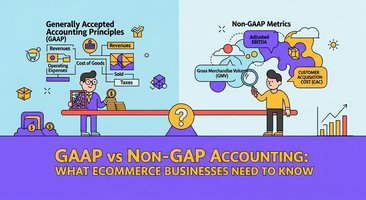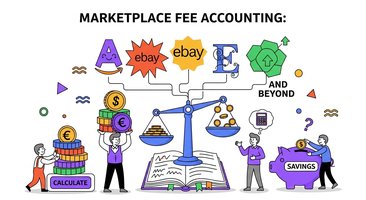Setting up a proper chart of accounts is one of the most critical foundational steps for any ecommerce business. Your chart of accounts (COA) serves as the backbone of your financial system, organizing every transaction into meaningful categories that provide insights into your business performance, profitability, and growth opportunities.
Unlike traditional brick-and-mortar businesses, ecommerce operations have unique financial complexities that require specialized account structures. From managing multiple sales channels and payment processors to tracking digital marketing expenses and inventory across various platforms, your chart of accounts must be designed to capture the nuances of online retail.
Understanding the Ecommerce Chart of Accounts
A chart of accounts is a systematic list of all financial accounts used to categorize and track your business transactions. For ecommerce businesses, this includes everything from sales revenue across different channels to platform-specific fees, shipping costs, and digital marketing expenses.
Why Ecommerce Businesses Need Specialized Charts of Accounts
Traditional accounting structures often fall short for ecommerce operations because they don't account for:
- Multiple sales channels (Amazon, Shopify, eBay, direct-to-consumer)
- Platform-specific fees and commissions
- Complex inventory management across warehouses and fulfillment centers
- Digital marketing attribution and customer acquisition costs
- International sales and currency conversions
- Subscription-based revenue models
- Returns and refunds processing
A properly structured ecommerce chart of accounts addresses these unique needs while maintaining compliance with accounting standards and providing actionable business intelligence.
Essential Account Categories for Ecommerce
Assets
Current Assets form the foundation of your balance sheet and include accounts that can be converted to cash within one year:
Cash and Bank Accounts
- Checking Account - Primary business operations
- Savings Account - Reserve funds and emergency capital
- PayPal Account - Digital payment processor balance
- Stripe Account - Credit card processing balance
- Money Market Account - Higher-yield cash reserves
Accounts Receivable
- Accounts Receivable - Outstanding customer payments
- Allowance for Doubtful Accounts - Estimated uncollectible receivables
Inventory
- Raw Materials - Components for manufactured products
- Work in Progress - Partially completed items
- Finished Goods - Ready-to-sell inventory
- Inventory in Transit - Goods being shipped to warehouses
- Consignment Inventory - Products held by third parties
Other Current Assets
- Prepaid Expenses - Insurance, software subscriptions, advertising
- Security Deposits - Warehouse leases, utility deposits
- Employee Advances - Cash advances to staff
Fixed Assets represent long-term investments in your business:
- Computer Equipment - Servers, laptops, tablets
- Software - Accounting systems, ecommerce platforms, CRM tools
- Furniture and Fixtures - Office equipment, warehouse fixtures
- Vehicles - Delivery trucks, company cars
- Accumulated Depreciation - Reduction in asset values over time
Liabilities
Current Liabilities include obligations due within one year:
- Accounts Payable - Outstanding supplier invoices
- Credit Card Payable - Business credit card balances
- Accrued Expenses - Earned but unpaid wages, utilities, rent
- Sales Tax Payable - Collected but unremitted sales taxes
- Income Tax Payable - Quarterly estimated tax payments
- Short-term Loans - Lines of credit, merchant cash advances
Long-term Liabilities encompass obligations extending beyond one year:
- Equipment Loans - Financing for machinery, vehicles
- SBA Loans - Small Business Administration financing
- Investor Notes - Convertible notes, term loans from investors
Equity
Equity accounts represent ownership in the business:
- Owner's Equity - Initial investment and retained ownership
- Retained Earnings - Accumulated profits reinvested in the business
- Additional Paid-in Capital - Investment above par value (corporations)
- Draws/Distributions - Owner withdrawals from the business
Revenue Account Structure
Primary Revenue Streams
Organizing revenue by source provides crucial insights into channel performance:
Sales Revenue by Channel
- Amazon Sales - FBA and FBM revenue
- Shopify Sales - Direct-to-consumer website sales
- eBay Sales - Marketplace transactions
- Wholesale Sales - B2B bulk orders
- Retail Sales - Physical store transactions (if applicable)
Service Revenue
- Shipping and Handling - Customer-paid shipping fees
- Installation Services - Product setup and installation
- Consulting Revenue - Expert advice and guidance
- Subscription Revenue - Recurring monthly/annual fees
Other Income
- Interest Income - Bank account and investment earnings
- Referral Commissions - Partner program earnings
- Insurance Reimbursements - Claims and settlements
- Foreign Exchange Gains - Currency conversion profits
Cost of Goods Sold (COGS) Categories
Properly tracking COGS is essential for accurate gross profit calculations:
Direct Product Costs
- Product Purchases - Wholesale inventory costs
- Manufacturing Costs - Production expenses for made-to-order items
- Packaging Materials - Boxes, bubble wrap, branded inserts
- Shipping Costs to Warehouse - Inbound freight charges
Labor Costs
- Direct Labor - Production and fulfillment staff wages
- Contract Labor - Temporary and seasonal workers
- Fulfillment Services - Third-party logistics (3PL) fees
Platform-Specific Costs
- Amazon FBA Fees - Fulfillment and storage charges
- Payment Processing Fees - Credit card and digital wallet fees
- Marketplace Commissions - Platform revenue sharing
- Advertising Costs - Pay-per-click and sponsored product ads
Operating Expense Categories
Sales and Marketing
Digital marketing represents a significant expense category for most ecommerce businesses:
- Google Ads - Search and display advertising
- Facebook Advertising - Social media marketing campaigns
- Amazon PPC - Sponsored product and brand campaigns
- Email Marketing - Platform subscriptions and design costs
- Influencer Marketing - Sponsorships and partnership fees
- SEO Services - Search engine optimization consulting
- Content Creation - Photography, videography, copywriting
- Trade Shows - Exhibition fees, booth setup, travel expenses
Administrative Expenses
- Office Rent - Physical workspace costs
- Utilities - Internet, phone, electricity, water
- Insurance - General liability, product liability, cyber security
- Legal and Professional Fees - Attorneys, accountants, consultants
- Software Subscriptions - Accounting, CRM, project management tools
- Office Supplies - Computers, furniture, stationery
- Bank Fees - Account maintenance, wire transfers, overdraft charges
Technology and Infrastructure
- Website Development - Design, programming, maintenance
- Hosting Fees - Server costs, CDN, security services
- Software Licenses - Operating systems, productivity suites
- Equipment Maintenance - Repairs and updates
- Data Storage - Cloud services, backup solutions
Ecommerce-Specific Account Considerations
Multi-Channel Revenue Tracking
Ecommerce businesses often sell across multiple platforms, making channel-specific revenue tracking essential:
- Create separate revenue accounts for each major sales channel
- Track platform-specific fees as direct costs against channel revenue
- Monitor channel profitability by comparing revenue to associated costs
- Use sub-accounts to break down revenue by product category within channels
Digital Marketing Attribution
Understanding customer acquisition costs requires detailed marketing expense tracking:
- Separate accounts for each major advertising platform
- Track organic vs. paid marketing expenses
- Monitor lifetime value against acquisition costs
- Allocate marketing expenses to specific product lines or channels
Inventory Valuation Methods
Choose the appropriate inventory accounting method for your business:
- FIFO (First-In, First-Out) - Assumes oldest inventory is sold first
- LIFO (Last-In, First-Out) - Assumes newest inventory is sold first
- Weighted Average Cost - Uses average cost of all inventory items
International Considerations
For businesses selling internationally:
- Foreign Exchange Gain/Loss - Currency conversion impacts
- International Shipping - Customs, duties, and international freight
- VAT/GST Accounts - Value-added taxes in international markets
- Transfer Pricing - Inter-company transactions for global operations
Technology Integration and Automation
QuickBooks Integration
Modern ecommerce businesses benefit significantly from integrated accounting systems:
- Automatic transaction import from sales channels
- Real-time inventory updates across platforms
- Streamlined bank reconciliation processes
- Automated sales tax calculations and reporting
Popular Ecommerce Integrations
- Shopify - Direct sales data synchronization
- Amazon - FBA fee tracking and inventory management
- PayPal - Payment processing and fee allocation
- Stripe - Credit card transaction processing
- WooCommerce - WordPress-based ecommerce integration
How Klavena Streamlines Chart of Accounts Setup
Klavena's comprehensive ecommerce accounting platform provides pre-configured chart of accounts templates specifically designed for online businesses. Our system includes:
Industry-Specific Templates
- Pre-built account structures for various ecommerce models
- Marketplace-specific fee tracking accounts
- Multi-channel revenue categorization
- Automated cost allocation across channels
Seamless Platform Integration
- Direct connections to major ecommerce platforms
- Automated transaction categorization
- Real-time inventory synchronization
- Comprehensive sales tax management
Advanced Reporting Capabilities
- Channel profitability analysis
- Customer acquisition cost tracking
- Inventory turnover reporting
- Cash flow forecasting
With Klavena's pre-configured options, businesses can implement a professional-grade chart of accounts in minutes rather than hours, ensuring accuracy and completeness from day one.
Best Practices for Chart of Accounts Management
Organization and Numbering
Implement a logical numbering system for easy navigation:
- 1000-1999: Assets
- 2000-2999: Liabilities
- 3000-3999: Equity
- 4000-4999: Revenue
- 5000-5999: Cost of Goods Sold
- 6000-6999: Operating Expenses
- 7000-7999: Other Income/Expenses
Account Naming Conventions
Use clear, descriptive account names that anyone can understand:
- Avoid abbreviations that might confuse team members
- Include channel or platform names in relevant accounts
- Use consistent terminology across related accounts
- Consider including account purposes in descriptions
Regular Review and Maintenance
- Quarterly review of account usage and relevance
- Annual cleanup of unused or duplicate accounts
- Regular reconciliation of all accounts
- Documentation of account purposes and usage guidelines
Scalability Planning
Design your chart of accounts to grow with your business:
- Leave room for new product lines and sales channels
- Plan for international expansion requirements
- Consider future financing and investor reporting needs
- Anticipate regulatory compliance requirements
Common Mistakes to Avoid
Over-ComplicationWhile detail is important, avoid creating too many accounts:
- Don't create separate accounts for every minor expense category
- Use sub-accounts sparingly and only when necessary
- Focus on accounts that provide actionable business intelligence
- Remember that you can always add accounts later
Under-CategorizationConversely, don't oversimplify your structure:
- Separate major expense categories for better analysis
- Track channel-specific revenue and costs
- Distinguish between different types of similar expenses
- Maintain separate accounts for different tax treatments
Inconsistent UsageEstablish clear guidelines for account usage:
- Document which expenses belong in each account
- Train all team members on proper categorization
- Regular review transactions for proper classification
- Implement approval processes for new account creation
Setting Up Your Chart of Accounts
Step 1: Choose Your Accounting Method
Decide between cash and accrual accounting:
- Cash Accounting - Record transactions when money changes hands
- Accrual Accounting - Record transactions when they occur (recommended for inventory-based businesses)
Step 2: Select Your Platform
Choose accounting software that integrates with your ecommerce operations:
- QuickBooks Online - Most popular choice for small to medium businesses
- Xero - Strong international features and integrations
- NetSuite - Enterprise-level solution for larger operations
- Klavena - Specialized ecommerce accounting platform
Step 3: Import or Create Accounts
- Start with industry-specific templates when available
- Customize based on your specific business model
- Test account structure with sample transactions
- Refine based on reporting needs
Step 4: Integrate with Sales Channels
- Connect major sales platforms for automatic data import
- Set up payment processor integrations
- Configure inventory synchronization
- Test data flow and accuracy
Step 5: Train Your Team
- Provide training on proper account usage
- Create documentation for common transactions
- Establish approval processes for unusual items
- Regular review and feedback sessions
Advanced Chart of Accounts Features
Department and Location Tracking
For businesses with multiple locations or departments:
- Use class tracking for departmental reporting
- Implement location-based profit and loss statements
- Track performance across different business units
- Allocate shared expenses appropriately
Project-Based Accounting
For businesses managing specific projects or campaigns:
- Create project codes for tracking profitability
- Allocate expenses to specific initiatives
- Monitor return on investment for marketing campaigns
- Track custom product development costs
Multi-Currency Considerations
For international ecommerce operations:
- Set up foreign currency accounts
- Track exchange rate fluctuations
- Implement proper conversion methodologies
- Monitor international tax obligations
Reporting and Analysis
Key Financial Reports
A well-structured chart of accounts enables powerful reporting:
Profit and Loss by Channel
- Revenue and expenses by sales platform
- Channel profitability analysis
- Customer acquisition cost tracking
- Marketing ROI measurement
Inventory Reports
- Inventory turnover by product category
- Dead stock identification
- Reorder point analysis
- Seasonal demand patterns
Cash Flow Analysis
- Operating cash flow trends
- Working capital requirements
- Seasonal cash flow patterns
- Investment and financing activities
Balance Sheet Analysis
- Asset utilization efficiency
- Debt-to-equity ratios
- Current ratio and liquidity measures
- Return on assets and equity
Compliance and Tax Considerations
Sales Tax Management
Ecommerce businesses face complex sales tax obligations:
- Track sales tax by jurisdiction
- Manage economic nexus thresholds
- Handle marketplace facilitator requirements
- Maintain proper documentation for audits
Income Tax Planning
Proper account structure supports tax efficiency:
- Separate deductible from non-deductible expenses
- Track depreciation schedules for assets
- Monitor quarterly estimated tax requirements
- Prepare for year-end tax planning opportunities
Regulatory Compliance
Maintain compliance with various regulations:
- Consumer protection laws
- Data privacy requirements
- International trade regulations
- Industry-specific compliance needs
Future-Proofing Your Chart of Accounts
Emerging Business Models
Plan for evolving ecommerce trends:
- Subscription-based revenue recognition
- Marketplace and platform business models
- Direct-to-consumer brand expansion
- Omnichannel retail integration
Technology Evolution
Prepare for advancing technology:
- Artificial intelligence and automation costs
- Blockchain and cryptocurrency transactions
- IoT and connected device expenses
- Advanced analytics and business intelligence
Global Expansion
Structure accounts for international growth:
- Multi-currency revenue and expense tracking
- International tax compliance
- Transfer pricing considerations
- Local regulatory requirements
Conclusion
A well-designed chart of accounts is essential for ecommerce success, providing the foundation for accurate financial reporting, strategic decision-making, and sustainable growth. By understanding the unique requirements of online businesses and implementing best practices for account structure and management, you can create a system that grows with your business and provides valuable insights at every stage of your journey.
The complexity of modern ecommerce operations demands sophisticated financial management tools and expertise. Whether you choose to implement your chart of accounts manually or leverage specialized platforms like Klavena's pre-configured solutions, the key is ensuring your system captures the unique aspects of your business while maintaining simplicity and usability.
Remember that your chart of accounts is a living document that should evolve with your business. Regular review, maintenance, and optimization ensure that your financial system continues to provide value as your ecommerce operation grows and adapts to changing market conditions.
By following the guidelines and best practices outlined in this guide, you'll be well-equipped to establish a robust financial foundation that supports informed decision-making, regulatory compliance, and long-term business success in the competitive world of ecommerce.





